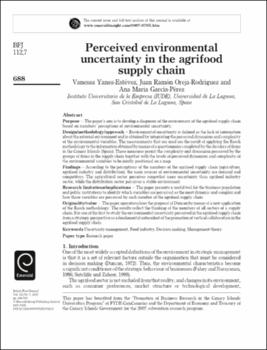Perceived environmental uncertainty in the agrifood supply chain.
Fecha
2010Resumen
Purpose – The paper’s aim is to develop a diagnosis of the environment of the agrifood supply chain
based on members’ perceptions of environmental uncertainty.
Design/methodology/approach – Environmental uncertainty is defined as the lack of information
about the external environment and is obtained by integrating the perceived dynamism and complexity
of the environmental variables. The measurements that are used are the result of applying the Rasch
methodology to the information obtained by means of a questionnaire completed by the deciders of firms
in the Canary Islands (Spain). Those measures permit the complexity and dynamism perceived by the
groups of firms in the supply chain together with the levels of perceived dynamism and complexity of
the environmental variables to be jointly positioned on a map.
Findings – According to the perceptions of the members of the agrifood supply chain (agriculture,
agrifood industry and distribution), the main sources of environmental uncertainty are demand and
competitors. The agricultural sector perceives somewhat more uncertainty than agrifood industry
sector, while the distribution sector perceives a stable environment.
Research limitations/implications – The paper presents a useful tool for the business population
and public institutions to identify which variables are perceived as the most dynamic and complex and
how those variables are perceived by each member of the agrifood supply chain.
Originality/value – The paper operationalises the proposal of Duncan by means of a new application
of the Rasch methodology. The results reflect the thinking of the members of all sectors of a supply
chain. It is one of the first to study the environmental uncertainty perceived in the agrifood supply chain
from a strategic perspective as a fundamental antecedent of the promotion of vertical collaboration in the
agrifood supply chain






